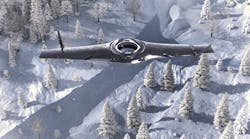BAE Systems has teamed with students from Cranfield University to develop a new form of unmanned aerial vehicle (UAV): a UAV that can alternate between fixed-wing and rotary-wing operation during the same mission. The aircraft use adaptive flight control and advanced navigation and guidance software to switch between the different operating modes as needed—fixed-wing operation for increased range and speed, and rotary-wing operation for the flexibility of vertical landings and takeoffs. The multiple modes of operation allow the UAVs to handle many different battle scenarios, including applications involving urban environments.
In rotary-wing mode, the Adaptable UAVs can dock on a special pole to simplify recovery from the battlefield. The pole limits the sideways movement of the UAV during a launch or landing for safe operation—even with strong winds and in cluttered environments, such as when surrounded by personnel on a ship or a land vehicle. The landing/take-off pole is gyro-stabilized so that it remains upright regardless of the orientation of the host vehicle.
UAVs are becoming more commonly used components within present-day battlefields, and reliance on unmanned ground, sea, and air vehicles of all sizes is expected to increase for defensive as well as offensive missions. “The battlefield of the future will require novel solutions to meet emerging threats and to keep human operators, safe wherever they might be,” said Professor Nick Colosimo, BAE Systems’ futurist and technologist. “The Adaptable UAVs concept and related technologies are one of a number of concepts being explored through close collaboration between industry and students in academia.”
Cranfield University (Cranfield, UK), which recently switched on a High Performance Computer (HPC) system called Delta to assist with complex research and simulations, is a Strategic University Partner of BAE Systems. “Working with BAE Systems on the Cranfield University MSc. in Autonomous Vehicle Dynamics & Control has provided a great opportunity for the students and research staff to explore a range of novel concepts and technologies,” said Professor Antionios Tsourdos, head of Cranfield University’s Centre for Autonomous and Cyber-Physical Systems.
As can be seen from the Adaptable UAV concept, the sharing of ideas provides unexpected departures from conventional ways of thinking and, in terms of defense systems, provides significant technological advantages.

